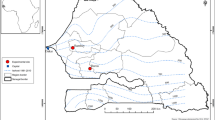Abstract
Grain molds in rainy season sorghums can cause poor grain quality resulting in economic losses. Grain molds are a major constraint to the sorghum production and for adoption of the improved cultivars. A complex of fungi causes grain mold. Information on genetics of grain mold resistance and mechanisms is required to facilitate the breeding of durable resistant cultivars. A genetic study was conducted using one white susceptible, three white resistant/tolerant sources, and one colored resistant source in the crossing programme to obtain four crosses. P1, P2, F1, BC1, and BC2, and F2 families of each cross were evaluated for the field grade and threshed grade scores, under sprinkler irrigation. Generation mean analyses and frequency distribution studies were carried out. The frequency distribution studies showed that grain mold resistance in the white-grained resistance sources was polygenic. The additive gene action and additive × additive gene interaction were significant in all the crosses. Simple recurrent selection or backcrossing should accumulate the genes for resistance. Epistasis gene interactions were observed in colored resistance × white resistance cross. Gene interaction was influenced by pronounced G × E. Pooled analysis showed that environment × additive gene interaction and environment × dominant gene interaction were significant. The complex genetics of mold resistance is due to the presence of different mechanisms of inheritance from various sources. Evaluation of segregating population for resistance and selection for stable derivatives in advanced generations in different environments will be effective.
Similar content being viewed by others
References
Audilakshmi, S., 1997. Genetics of grain-mold resistance and yield components in sorghum (Sorghum bicolor) varieties. Ph.D. Thesis, submitted to Osmania University, Hyderabad, India.
Audilakshmi, S., J.W. Stenhouse, T.P. Reddy & M.V.R. Prasad, 1999. Grain mold resistance and associated characters of sorghum genotypes. Euphytica 107: 91–103.
Bandyopadhyay, R. & L.K. Mughogho, 1988. Evaluation of field screening techniques for resistance to sorghum grain molds. Plant Dis 72: 500–503.
Cavalli, L.L., 1952. An analysis of linkage in quantitative inheritance. In: E.C.R. Reeves & C.H. Waddington (Eds.), Quantitative Genetics, pp. 135–144. HMSO, London.
Dabholkar, A.R. & S.S. Baghel, 1983. Diallel analysis of grain mold resistance in sorghum. Genet Agraria 37: 327–334.
Forbes, G.A., R. Bandyopadhyay & G. Gracia, 1992. A review of sorghum grain mold. In: W.A.J. de Milliano, R.A. Frederkisen & G.D. Bengston (Eds.), Sorghum and Millets Diseases: A Second World Review, pp. 253–264. International Crops Research Institute for the Semi-Arid Tropics, Patancheru, India.
GENSTAT 5, 1993. GENSTAT 5 Committee of the Statistics Department, Rothamsted Experimental Station. AFRC Institute of Arable Crops Research, Harpenden, Hertfordshire, UK.
Hayman, B.I., 1958. The separation of epistatic from additive and dominance variation in generation means. Heredity 12: 371–390.
ICRISAT & FAO, 1996. World Sorghum and Millet Economics: Facts, Trends, and Outlook, Patancheru, A.P., India, p. 68. International Crops Research Institute for the Semi-Arid Tropics and Viale delle Terme di Caracalla, Rome, Italy, Food and Agriculture Organization of the United Nations.
Kataria, S.K., R. Singh & P.K. Shrotria, 1990. Inheritance of resistance to grain mold fungi in three sorghum, Sorghum bicolor crosses. Environ Ecol 8: 1111–1113.
Mather, K. & J.L. Jinks, 1971. Biometrical Genetics. Cornell University Press, Ithaca, NY.
Mather, K. & J.L. Jinks, 1977. Introduction to Biometrical Genetics. Cornell University Press, Cambridge, UK.
Murty, D.S. & L.R. House, 1984. Components of generation means for resistance to grain mold-causing fungi Curvularia and Fusarium in sorghum. Cereal Res Commun 12: 237–244.
Narayana, D. & M.N. Prasad, 1983. Inheritance of resistance to Fusarium grain mold in sorghum. In: Abstracts of Contributed Papers, Part 2, of the Fifteenth International Congress of Genetics, December 12—21, 1983, p. 727. Oxford and IBH, New Delhi, India.
Rana, B.S., M.H. Rao, S. Indira, B.U. Singh, S.S. Rao & G.P. Lodhi, 1997. Introduction. In: XXVII Annual Group Meeting held at Tamil Nadu Agricultural University, Coimbatore, April 28–30, 1997. All India Co-ordinated Sorghum Project, Hyderabad, India.
Rodriguez-Herrera, R., W.L. Rooney, D.T. Rosenow & R.A. Frederiksen, 2000. Inheritance of grain mold resistance in grain sorghum without a pigmented test. Crop Sci 40: 1573–1578.
Torres, A.M., M.T. Moreno & J.I. Cubero, 1993. Genetics of six components of autofertility in Vicia faba. Plant Breed 110: 220–228.
Author information
Authors and Affiliations
Corresponding author
Rights and permissions
About this article
Cite this article
Audilakshmi, S., Stenhouse, J.W. & Reddy, T.P. Genetic analysis of grain mold resistance in white seed sorghum genotypes. Euphytica 145, 95–101 (2005). https://doi.org/10.1007/s10681-005-0534-6
Received:
Accepted:
Issue Date:
DOI: https://doi.org/10.1007/s10681-005-0534-6



